Varicose veins can occur in various parts of the body, but the most common are varicose veins in the lower extremities. This disease is characterized by a violation of blood outflow, which stagnates in the leg veins. In medicine, varicose veins of the lower extremities are interpreted as a disease accompanied by an increase in length, the appearance of a serpentine tortuosity of the saphenous veins, as well as a sac-like increase in their lumen. The disease is diagnosed in 17-25% of the population. In addition, women are three times more likely to be affected by this disease than men.
Causes of the disease
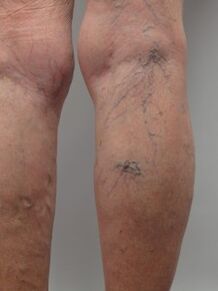
The main causes of the disease are:
- heredity;
- older age;
- obesity;
- Wearing tight underwear and uncomfortable, especially narrow, high-heeled shoes.
The influence of heredity on the occurrence and development of varicose veins has not yet been proven. However, it should be noted that in some families, varicose veins occur quite frequently across several generations. It is noted that the predominant factors for the onset of the disease are diet, a specific lifestyle and changes in the hormonal cycle.
The main risk factor for developing the disease is obesity, with the incidence of varicose veins increasing depending on the severity of obesity.
Excess weight is associated with a sedentary lifestyle and an incorrectly organized diet. For example, in the modern world, processed foods predominate, and there is a shortage of plant fiber contained in raw vegetables, berries and fruits. Plant fiber is important for strengthening vascular walls and reducing intra-abdominal pressure, which also helps reduce the risk of disease.
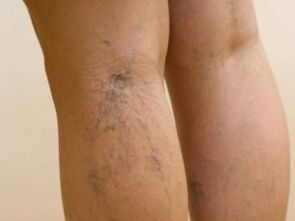
In addition to proper nutrition, the work routine should also be properly organized. As a rule, people spend a significant part of their working time standing or sitting, which has a negative effect on the function of the venous valve system. Hard physical work, which involves heavy strain on the legs when lifting heavy objects, is also considered unfavorable. Another risk factor affecting the development of the disease is long trips or flights, which are accompanied by the appearance of blood stagnation in the leg veins.
Another pressing cause of the disease is fashion. Tight underwear compresses the veins in the groin folds, and corsets significantly increase intra-abdominal pressure, which leads to varicose veins. Wearing high-heeled shoes is considered extremely harmful, especially when combined with uncomfortable arch supports.
A proven risk factor for venous disease is repeated pregnancy, which leads to changes in intra-abdominal pressure, while the hormone progesterone affects the venous walls and destroys collagen and elastic fibers.
Symptoms of varicose veins of the lower extremities
The main symptoms of this disease are:
- veins that protrude under the skin,
- Swelling,
- Pain in the legs, especially in the evening,
- I feel tired
- Changes in skin appearance – pigmentation, thickening,
- Loss of skin elasticity, hair loss in areas where there are dilated veins.
The main visible signs of varicose veins are sac-like or cylindrical dilations of the superficial veins. The veins become unnaturally tortuous and protrude above the surface of the skin in the legs and feet. The largest varicose veins are resolved after long physical work.
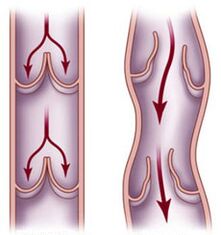
In the first stage of varicose veins, the symptoms are mild and non-specific. The only symptom at this stage is a feeling of heaviness in the legs. Also of concern is rapid fatigue, a burning sensation in the legs that is annoying after physical activity. Sometimes there is short-term swelling and aching pain along the veins. Characterized by mild swelling of the back of the foot and ankles, which often occurs in the evening after prolonged monotonous physical activity. In the morning the swelling disappears without a trace and there is no visible expansion of the veins.
When these signs appear, it is imperative to consult a specialist in a timely manner to prevent the progression and development of the disease. If treated improperly, a neglected situation leads to chronic venous insufficiency.
An important symptom of venous insufficiency is spider veins - a network of dilated capillaries (0. 1 mm or more) visible through the skin. Women consider such "stars" to be a cosmetic defect, men simply do not notice them. Sometimes this is just a manifestation of hormonal disorders, abuse of the sauna or solarium. However, in most cases, spider veins are one of the first signs of venous congestion and the development of varicose veinsIf such a disease occurs in a relatively small area of the skin, you should definitely see a specialist.
Diagnosis of varicose veins
A vascular surgeon can diagnose varicose veins through a routine examination, an ultrasound scan of the veins, and also through phlebography, which involves injecting special medications into a vein and monitoring its response.
When you visit your doctor, you will be offered a special examination consisting of several procedures.
- A blood test (general) that shows the degree of thickening, blood clotting (susceptibility to thrombosis) and the presence or absence of inflammation (confirmation of thrombophlebitis).
- Ultrasound of the veins, which identifies the affected areas. To detect signs of varicose veins, it is recommended that a vascular ultrasound examination be carried out, even if spider veins have already appeared.
- Rheovasography is a method that uses mathematical calculation to determine the insufficient blood supply (nutrition) to the tissue. In this way, the stage of the disease is determined, which is necessary for selecting treatment methods.
- Surgical methods such as venography (see above) are only very rarely used to assess the condition of the venous system.
Treatment methods for varicose veins
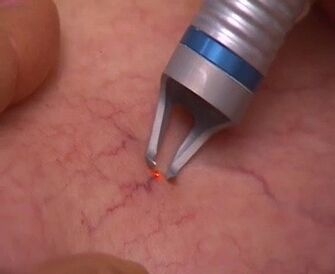
Treating varicose veins is quite difficult, so it is recommended to prevent them. Conservative treatment methods include special tablets and ointments prescribed by a doctor, wearing tights and stockings with special drawstrings. Surgical treatment of varicose veins is also possible, in which enlarged veins are removed using the traction method. Laser therapy and sclerotherapy are considered very effective.
Varicose veins are extremely concerning for patients from a cosmetic perspective. Doctors consider an operation necessary. To reduce the risk of complications and speed up recovery, specialists prescribe a special micronized drug that increases the tone of the veins, relieves inflammatory reactions and stimulates lymph flow.
Non-surgical treatment
Non-surgical treatment of varicose veins is only successful at the beginning of the disease, when the skin symptoms are mild and moderately affect the ability to work. Conservative therapy is carried out when surgical treatment is contraindicated. This method is also mandatory in the postoperative period to prevent recurrence of the disease.
Conservative treatment is:
- Reducing the influence of risk factors,
- sufficient physical activity,
- elastic compression,
- medication,
- Use of physiotherapy.
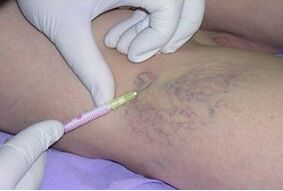
People with risk factors for the development of varicose veins or a hereditary predisposition should visit a phlebologist twice a year and undergo an ultrasound scan of the veins.
With conservative treatment, it is necessary to constantly exercise the veins, elevate the feet for a long time and wear only comfortable, comfortable shoes.
Hiking is shown as well as swimming and cycling. Physical activity should be carried out only under the condition of elastic compression. Elastic compression is a conservative method of treating varicose veins using an elastic bandage or medical knitwear. It is contraindicated to practice traumatic sports such as football, volleyball and others.
For varicose veins, the use of phlebotonic medications is recommended. The effect of such drugs is aimed at strengthening the walls of the veins.
All folk remedies, including medicinal herbs, will never be as effective as pharmaceuticals. You shouldn't self-medicate; Any drug therapy is only carried out as prescribed by a doctor. Local treatment is carried out only if there is no thrombosis or thrombophlebitis.
Surgical treatment methods
Complete cure of varicose veins of the lower extremities can only be achieved through surgical treatment.
The following surgical treatment methods are used:
Phlebectomy— Removal of varicose veins during surgery. This procedure is contraindicated if the patient has a severe concomitant disease or late stage varicose veins.
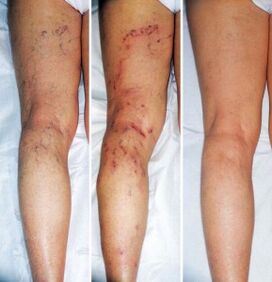 The operation is not performed during pregnancy, in the presence of purulent processes in the body or in the elderly.
The operation is not performed during pregnancy, in the presence of purulent processes in the body or in the elderly.The use of endoscopic treatment methods makes such an operation as safe as possible and cosmetically advantageous. The package of measures for rapid recovery after surgery depends entirely on the complexity of the surgical procedure, taking into account general principles. The final sutures are formed after 6 months. In order to avoid damage and cosmetic defects, rough mechanical influences (use of a hard sponge, tight, uncomfortable clothing) must be excluded. Do not wash with hot water. After the operation, elastic compression must be applied for 6 months. In the future, compression stockings will be necessary for "harmful" stress (heavy lifting, long journeys).
sclerosis- Injection of a special substance (sclerosing agent) into a vein, which causes "gluing" of the vein walls, thereby stopping blood flow. In this way, the cosmetic defect is eliminated, since the vein becomes invisible. This method is effective only when small branchesThe main vein trunks can be expanded. After the venous sclerosis procedure, the patients do not require any rehabilitation.
Laser coagulation— destruction of the venous wall under the action of a laser, as a result of which the lumen of the veins is "sealed". Indicated for people whose venous dilatation is no more than 10 mm. The procedure requires anesthesia, early activation of the patient and long-term elastic compression.
Prevention of varicose veins of the lower extremities
Currently, great importance is attached to the prevention of varicose veins. It is necessary to regularly carry out simple measures that can significantly reduce not only the risk of occurrence, but also the development and progression of the disease.
- An active lifestyle, moderate alternation of long static loads with other physical activities such as walking, running, cycling, swimming and performing simple exercises at work.
- Keep your legs in an elevated position frequently.
- Follow a diet and monitor your weight.
- Wearing comfortable shoes with a heel height of a maximum of 4 cm and using orthopedic insoles makes sense.
- When using estrogens, contraceptives or during pregnancy, an ultrasound examination of the veins of the lower extremities is necessary.
Our health depends only on ourselves, and in order to remain a happy person who does not suffer from diseases, it is important to carefully monitor your lifestyle, be physically active and eat right.

























